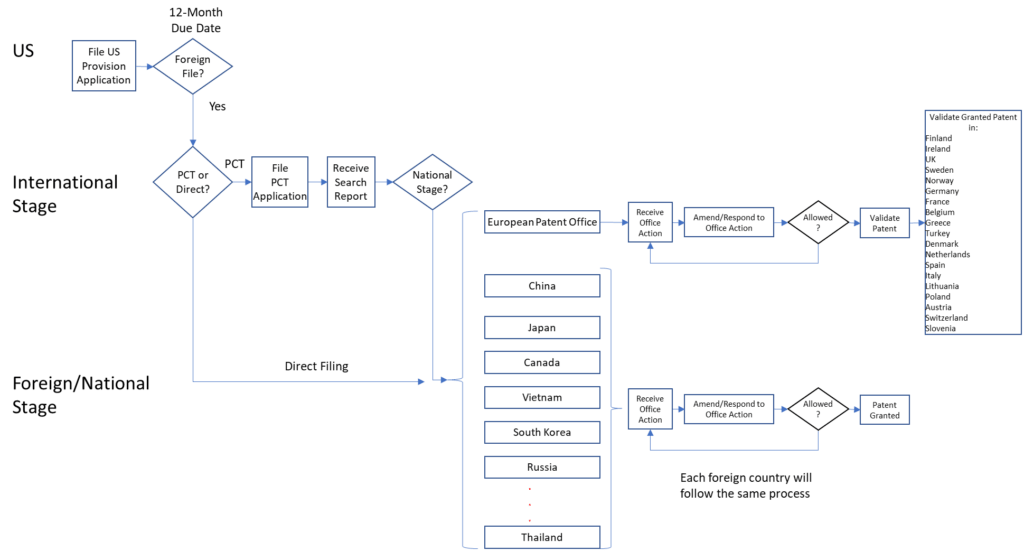Your patent is finally filed in the United States Patent and Trademark Office (or the office of your local country). Then you remember your attorney saying something about patents being jurisdictional, whatever that means….
Once you have filed your initial patent application, which is sometimes referred to as the “priority” application, you have 12 months to take additional steps to protect your invention in other countries or regions. Patents issued by a particular government are enforceable only in that country. In other words, you can only prevent others from making, using, selling, offering for sale, importing, or exporting the invention in that country. If your competitor makes and sells the product in a neighboring country, there is nothing you can do about it unless you also have a patent there.
There are a number of ways to protect your invention outside the country of your initial filing. These options were originally enabled by a treaty signed back in 1883, called the Paris Convention on Industrial Property. The Paris Convention enables you to file additional patent applications in other countries after your initial filing, but they will have the same effective filing date as your priority application. Why is this important? If this were not the case, you would have to file all your patent applications everywhere in the world on the same day. It would be a logistical nightmare, and the costs would be prohibitive. In addition to the Paris Convention, inventors may also seek protection under the Patent Cooperation Treaty (PCT).
Decision making at the international stage of the process is very important because the costs can add up quickly. The basic filing fee in the United States is relatively modest, but some countries charge many multiples of the US fee. Further, depending on the countries chosen, there may be fees for translations and for attorneys who file the applications in those foreign countries.
One item you should note is that you will sometimes see a reference to a “country/regional” patent office. What is a regional patent office? In some places, groups of countries have joined to prosecute patent applications in a single location for all the countries in that region. The best example of this is the European Patent Office, which allows a single prosecution for 38 member states. Other regional patent systems include the African Regional Intellectual Property Office (ARIPO) and the Eurasian Patent Organization (eight former countries of the Soviet Union). Note that the Gulf Cooperation Council (in the Middle East) stopped accepting new applications in January 2021.
Choosing the countries in which to file can get very complicated. And in the legal field, complicated means costly. A high-level chart of this process is below.

As you can see, the process can take many branches, depending on the choices made. Because these decisions are highly dependent on your (or your company’s) circumstances, it is worthwhile to talk with a patent professional to achieve your goals without breaking the bank.
We briefly discuss the first two options: (1) filing directly with the respective patent office of each country/region where you want protection under the Paris Convention or (2) filing a patent application with the World Intellectual Property Organization under the PCT. The strategy you chose will depend on your goals and finances:
- Filing Direct—This option is typically recommended when the number of countries where protection is desired is relatively small, when the client knows exactly in which countries it wants protection, or when a large budget is available for filing.
- PCT Application—The PCT application allows you to postpone the direct filing of the national applications (referred to as “national stage” applications) until 30 months from your earliest filing date. It is important to note that a PCT application does not result in a patent. During the PCT phase, the PCT examiner performs a search and provides a preliminary assessment of the patentability of the claims. There is an optional second stage in which an examination is performed (referred to as Chapter II). A PCT application may be desirable for the following reasons:
- The client needs more time to decide in which countries to file.
- The client wants to review the PCT search report before investing in foreign applications.
- The decision to file foreign applications was made too close to the due date, and there isn’t sufficient time to transmit the necessary documents (or obtain translations) in each of the desired countries.
One caveat on the PCT application is that as of this writing, 155 countries are members of the PCT (called contracting states); however, 178 countries are members of the Paris Convention. Further complicating matters, some regional patent systems (e.g., ARIPO) are also members of the PCT, but not all of their respective countries are PCT contracting states. As a result, you may initially strategize to file a PCT and then a national stage application in ARIPO but then find that Eswatini is not a member. If Eswatini is a country you care about, you need to file an application there 12 months from the filing of the priority application.
Depending on your needs, filing foreign utility patents can be a complicated subject. In the near future, we will discuss in another article the considerations of which countries to file in outside your home country.
